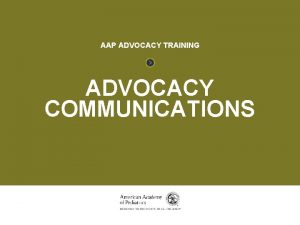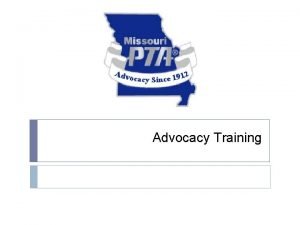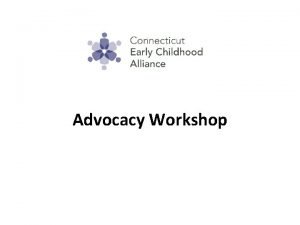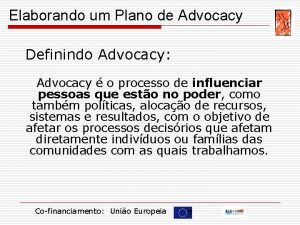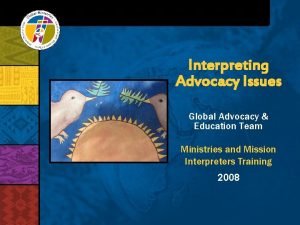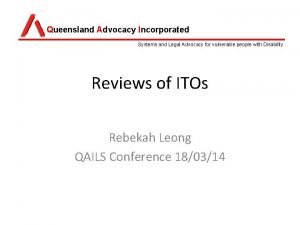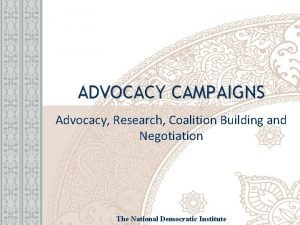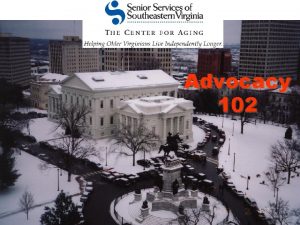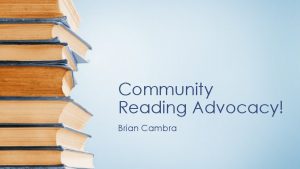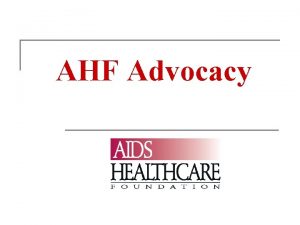MODULE 4 ADVOCACY OUTLINE FOR THIS MODULE Advocacy






































- Slides: 38

MODULE 4: ADVOCACY

OUTLINE FOR THIS MODULE Advocacy Promoting the Health of Formerly Incarcerated People Review and Assessment Service Learning

REVIEW What did we learn last week? What stands out from the first three modules? What has been reinforced through your Service Learning experiences?

ADVOCACY AND COMMUNITY ORGANIZING

LEARNING OBJECTIVES By the end of this section, you will be able to: Define and discuss community organizing. Explain the difference between advocacy and community organizing. Discuss at least two ways that contemporary models of community organizing are different from models used in the past. Explain the five steps of the Community Action Model. Discuss the CHW’s roles and responsibilities in the community organizing process and put them into practice. Apply the Community Action Model to issues facing the communities you work with. Explain the importance of integrating news media and social media into organizing efforts.

WORDS TO KNOW § Community organizing § Media advocacy § Power analysis § Social media

DEFINING COMMUNITY A community shares a commonality such as: Neighborhood. Race / ethnicity. Gender / gender identity / sexual orientation. Can be in person or virtual. A community defines itself.

COMMUNITY ORGANIZING § Actions taken by a group of people who have been denied participation in a decision-making process. § By working together, they create social change, which results in new resources, rights, improved health and living conditions.

WHY ORGANIZE? § People without power and control, can get together to assert their needs and create a better life. § CHWs develop relationships with the communities and can facilitate community organizing.

EXAMPLES OF ORGANIZING Labor movements § § Safe working conditions. Right to organize. Limits to working hours. Living wage. American Disabilities Act (ADA). United Farm Workers. Civil Rights Movement. Act Up. Health issues High rate of infant mortality. Pollution. HIV/AIDS. Drug use / needle exchange. Incarceration. Homelessness.

DIFFERENCES BETWEEN ADVOCACY AND ORGANIZING Advocacy Working on behalf of people. Supporting process / cause. Working on passing or implementing policy. Grass roots or professional. Uses voices of the people. May/may not involve community organizing. Community Organizing Mobilizes community to act on their behalf. Grassroots led. Shifts power to the people. Develops community’s skills. Often is collaborative.

MODELS OF COMMUNITY ORGANIZING Community capacity building. Collaborative partnerships. Consensus organizing. Mass mobilization.

STRATEGIES AND TACTICS Popular education. Policy 101. Develop model policy recommendations. Media advocacy. Social media.

MEDIA ADVOCACY Media can be used to: Inform — the public about the consequences. Recast — the problem affects everyone. Encourage — community members to get involved. Promote — agencies that address the problem.

https: //sanfranciscotobaccofreeproject. org

COMMUNITY ACTION MODEL (CAM) Goals Environmental or social change. Empowerment and community leadership. Fundamentals Achievable. Sustainable. Compelling.

COMMUNITY ACTION MODEL (CAM) 1. Identify the problem. 2. Assess the problem / community diagnosis. 3. Analyze findings. 4. Identify and implement an advocacy action. 5. Maintain actions and results.

CHW ROLES IN ORGANIZING AND ADVOCACY SHOULD Commit to social justice. Cultural humility. Develop and maintain trust with community. Active listening. Provide resource information. Group facilitation. Flexibility. Client-centered approach. SHOULD NOT Assume anything. Be the leader. Decide who participates. Prioritize tasks and activities. Make key decisions. Ignore community. Ignore historical issues.

ROLES AND RESPONSIBILITIES IN ORGANIZING Plan with people, not for them. Have goals and strategies. Plan the process. Identify leaders. Stay grounded in the community. Work with diversity. Build relationships. Bridge the language barriers. Cultivate the media. Safety comes first. Be committed. Assist with the research. Take care of yourself.

GROUP ACTIVITIES

PROMOTING THE HEALTH OF FORMERLY INCARCERATED PEOPLE

LEARNING OBJECTIVES By the end of this section, you will be able to: Analyze the ways that incarceration Examine best practices and emerging influences the health of individuals, models for promoting the health of families and communities. formerly incarcerated people. Identify common health issues faced Identify areas of potential policy by formerly incarcerated people. change and the role of CHWs as advocates for change. Explain the stigma and the systemic barriers to reintegration faced by newly Learn about resources for successful released prisoners. re-entry. Discuss the role of CHWs in promoting the health and well-being of formerly incarcerated clients.

WORDS TO KNOW Recidivism Re-entry

GROUP ACTIVITY 15. 1 MYTH AND REALITY ICE BREAKER

BASIC TERMS AND LANGUAGE Jail vs. Prison Jail — run by county, holds people waiting for trial or with short sentences. Prison — state or federal, holds people who have been convicted. Detention Centers hold people: Suspected of crime. Awaiting trial or sentencing. Undocumented immigrants. Probation and Parole Probation — alternative to prison; serving a sentence in the community under strict requirements. Parole — early release from prison.

WHY IS LANGUAGE SIGNIFICANT? Words like “offender, ” “convict” or “felon” carry stigma. Instead, we will use “incarcerated person” or “formerly incarcerated person. ”

INCARCERATION IN THE UNITED STATES War on drugs: mandatory minimums, aimed at men of color. Three strikes: mandated life sentences for some three-time offenders; huge increase in number of incarcerated people and new prisons.

HEALTH CONDITIONS BEHIND BARS One in three have a chronic illness, including hypertension, asthma, cervical cancer and arthritis. HIV and HCV (hepatitis C) HIV rates five times higher. HCV rates 9 -10 times higher. Sex, tattoo's, IV drug use. TB and MRSA: overcrowding and unsanitary conditions. Poor medical care: access, delays, inadequate, incompetent, lack of preventative care. Immigration detention: 400, 000 each year.

MENTAL HEALTH One in six people in U. S. prisons has a mental illness. Three out of four have a history of substance abuse. Many are victims of trauma and violence. They often leave jail sicker than when they went in.

SOCIAL CONDITIONS Denied privacy and control. Encouraged to hide feelings and fear. Prolonged periods of social and physical isolation. Sexualization of women by male guards. Anti-LGBTQ harassment and violence.

IMPACT ON FAMILIES AND COMMUNITIES Family health and wellbeing. Re-entry challenges: Human cost. Financial and emotional impacts. Loss, abandonment, extreme anxiety. Maintain family ties. Severing parental rights. Housing. Employment. Ban on education assistance. Public benefits. Disenfranchisement. Family reunification. Stigma and discrimination.

CHALLENGES OF RE-ENTRY Housing. Employment. Ban on financial aid for education. Public benefits. Disenfranchisement. Family reunification. Stigma and discrimination.

BEST PRACTICES AND EMERGING MODELS Post-Release Wellness Project (PRWP). Transitions Clinic Network (TCN). Project Bridge. Hampden County. Prison Activists Resource Center.

BANNING THE BOX Restoration of civil and human rights. Elimination of questions about past convictions on initial public applications. Housing applications. Employment. Social services. Structural discrimination. Stability to families and communities.

CHW ROLE Client-centered approach. Understanding values, beliefs and goals. Ethical dilemmas. Promoting partnerships, advocating for change.

GROUP ACTIVITY 15. 4 RE-ENTRY OBSTACLE COURSE

REVIEW – WHAT HAVE WE LEARNED TODAY?

SERVICE LEARNING
 Example of sentence outline about education
Example of sentence outline about education Aktiv exspektans
Aktiv exspektans Jag har nigit för nymånens skära
Jag har nigit för nymånens skära Inköpsprocessen steg för steg
Inköpsprocessen steg för steg Strategi för svensk viltförvaltning
Strategi för svensk viltförvaltning Relativ standardavvikelse formel
Relativ standardavvikelse formel Datorkunskap för nybörjare
Datorkunskap för nybörjare Tack för att ni har lyssnat
Tack för att ni har lyssnat Klassificeringsstruktur för kommunala verksamheter
Klassificeringsstruktur för kommunala verksamheter Vad står k.r.å.k.a.n för
Vad står k.r.å.k.a.n för Läkarutlåtande för livränta
Läkarutlåtande för livränta Påbyggnader för flakfordon
Påbyggnader för flakfordon Tack för att ni lyssnade
Tack för att ni lyssnade Tobinskatten för och nackdelar
Tobinskatten för och nackdelar Egg för emanuel
Egg för emanuel Atmosfr
Atmosfr Rutin för avvikelsehantering
Rutin för avvikelsehantering Mitos steg
Mitos steg Byggprocessen steg för steg
Byggprocessen steg för steg Tidbok yrkesförare
Tidbok yrkesförare Fspos
Fspos Myndigheten för delaktighet
Myndigheten för delaktighet Presentera för publik crossboss
Presentera för publik crossboss Fuktmätningar i betong enlig rbk
Fuktmätningar i betong enlig rbk Kung som dog 1611
Kung som dog 1611 Tack för att ni har lyssnat
Tack för att ni har lyssnat Stig kerman
Stig kerman Hur ser ett referat ut
Hur ser ett referat ut Fimbrietratt
Fimbrietratt Varför kallas perioden 1918-1939 för mellankrigstiden
Varför kallas perioden 1918-1939 för mellankrigstiden Karttecken stig
Karttecken stig Formel för lufttryck
Formel för lufttryck Avrunda decimaltal
Avrunda decimaltal Elektronik för barn
Elektronik för barn Borra hål för knoppar
Borra hål för knoppar A gastrica
A gastrica Smärtskolan kunskap för livet
Smärtskolan kunskap för livet Bris för vuxna
Bris för vuxna Bra mat för unga idrottare
Bra mat för unga idrottare







































